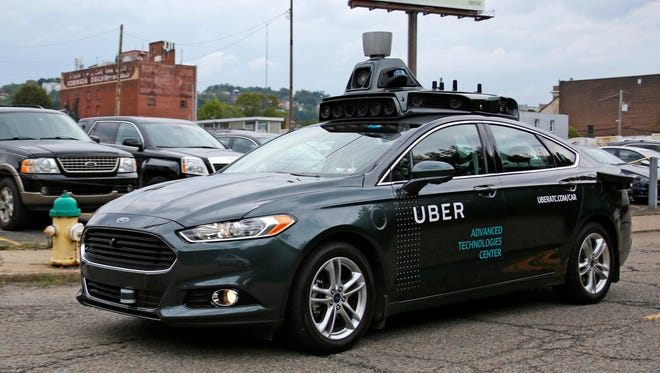Feds unveil plan to ensure safety of self-driving cars

SAN FRANCISCO — Federal regulators, faced with a growing number of self-driving car tests on roads across the U.S., plan to issue a flurry of new guidelines Tuesday aimed at automakers and tech companies.
The U.S. Department of Transportation will require any new tech to meet a 15-point safety assessment, consider new powers to allow administrators to limit the deployment of experimental vehicles, and will issue a model for state self-driving car policies aimed at developing a cohesive set of national regulations.
Officials will solicit public comments on the topic of self-driving car regulations for the next 60 days on the Transportation Department website and plan to update self-driving car policies annually.
"We’re laying it out there, what we care about, and inviting the industry to show us how they meet those standards," Department of Transportation Secretary Anthony Foxx told reporters during a briefing late Monday. "Some companies haven’t dealt with us, but they’ll learn quickly we can go really deep on these topics. We want the public to be safe."
Why self-driving Ubers are rolling around Pittsburgh
President Obama hammered home his administration's message with an editorial posted late Monday on the website of the Pittsburgh Post-Gazette (Pittsburgh is home to Uber's self-driving car research facility and the first city in which it is testing autonomous vehicles).
"Regulation can go too far," Obama writes. "Government sometimes gets it wrong when it comes to rapidly changing technologies. That’s why this new policy is flexible and designed to evolve with new advances."
He allows that some argue government "should stay out of free enterprise entirely, but I think most Americans would agree we still need rules to keep our air and water clean, and our food and medicine safe. That’s the general principle here. What’s more, the quickest way to slam the brakes on innovation is for the public to lose confidence in the safety of new technologies."
Government officials stressed that they reserve the right to create new rules for the nascent industry, and reiterated that the National Highway Traffic Safety Administration will have the power to "remove from the road" any vehicle whose technology poses a safety risk.
The agency specifically noted that certain semi-autonomous driving systems - "ones in which the human continues to monitor the driving environment and perform some of the driving task" -- may be subject to recall.
While many automakers offer such driver aids, electric-car maker Tesla Motors has been in the spotlight for a few fatal crashes in Florida and China where its Model S sedans may have engaged the car's Autopilot partial self-driving system. NHTSA is investigating the Florida incident.
NHTSA administrator Mark Rosekind declined to say whether any action would be taken against the electric automaker.

More broadly, Rosekind said the new rules would require companies making driver-assist tech to determine "how much a driver needs to stay vigilant, and then identify where their tech fits, which will be evaluated by NHTSA and the Department of Transportation to see if what they say are providing fits into that classification."
Getting a peek under the hood of self-driving tech before it is deployed represents a radical departure for the department, which traditionally sets guidelines for automakers and then uses recalls to address defective cars.
It's a 50,000-pound semi. And, now it's self-driving
"As far as I know, this is unprecedented," said Foxx. "We’ll have to be flexible in understanding a lot of different types of technologies, (but) through this guidance, we can make safety a first-tier priority in this emerging area."
Gartner automotive analyst Mike Ramsey remains skeptical about the government's ability to properly evaluate cutting edge auto tech.
"They may be asking companies to make sure they meet that 15-point safety assessment, but the devil is in the details," says Ramsey. "With technology, you could argue that once you know what the test is, you can make sure you ace the test."
Foxx acknowledged that the fierce war for talented self-driving car engineers could make it difficult to ensure that government agencies are properly staffed.
"I’ve been vexing out this for some time," he said. "I didn’t want this tech to hit our doors and have our department be unprepared to deal with it on its own terms. Will there be competencies we need to build into the department? Entirely possible."
$999 self-driving car kit vows to turn your car into a Tesla
Foxx said his agency would be evaluating any non-traditional autonomous vehicle designs and consider creating new federal standards for designs that remove the steering wheel and pedals from cars. Both Ford and Google have made it explicitly clear such vehicles are their mission.
California's Department of Motor Vehicles is evaluating its rules on cars without steering wheels and pedals.
Ford, Google and others are currently testing cars with safety drivers in the driver's seat in California. Google is also road-testing its autonomous fleet in Texas, Arizona and Washington. Ford is testing in Michigan, while Uber recently began picking up passengers in Pennsylvania.
In addition to big automakers and established tech companies, a growing number of startups also are entering the race to automate vehicles. Those include Bay Area companies such as Comma.ai, Drive.ai and Cruise Automation, which was recently bought by General Motors for $1 billion.
In short order, self-driving cars have gone from science fiction to Google "moonshot" project to crowded battlefield. On Sunday, Lyft cofounder John Zimmer issued a long manifesto on Medium that promoted a self-driving future, one in which most of his ride-hailing company's cars would drive themselves by 2021.
Joe Okpaku, Lyft's vice president of government relations, hailed the new rules.
"Flexibility and innovation must also be preserved as this entirely new form of transportation comes to market," he said in a statement. "Much work remains ahead, but NHTSA's guidelines are a step in the right direction."
Follow USA TODAY tech reporter Marco della Cava @marcodellacava